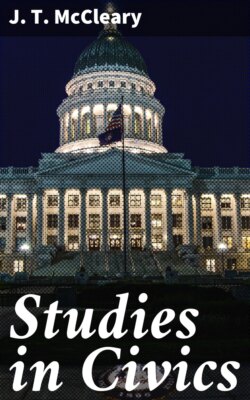Читать книгу Studies in Civics - J. T. McCleary - Страница 21
На сайте Литреса книга снята с продажи.
PRELIMINARY TO TRIAL.
ОглавлениеComplaint and Summons.—In bringing a civil action, the plaintiff or his agent appears before the justice of the peace and files a Complaint. In this he states the cause of the action. The justice then issues a Summons. This is an order to a sheriff or constable commanding him to notify the defendant to appear before the justice at a certain time and place to make answer to the plaintiff's demands. (Form on p. 277.)
Sometimes on bringing an action or during its progress a writ of attachment is obtained. To secure this writ, the creditor must make affidavit to the fact of the debt, and that the debtor is disposing or preparing to dispose of his property with intent to defraud him, or that the debtor is himself not reachable, because hiding or because of non-residence. In addition, the creditor must give a bond for the costs of the suit, and for any damages sustained by the defendant. The justice then issues the writ, which commands the sheriff or constable to take possession of and hold sufficient goods of the debtor and summon him as defendant in the suit.
Another writ sometimes used is the writ of replevin. To secure this writ, the plaintiff must make affidavit that the defendant is in wrongful possession of certain (described) personal property belonging to the plaintiff. The plaintiff then gives a bond for the costs of the suit and for the return of the property in case he fails to secure judgment, and for the payment of damages if the return of the property cannot be enforced, and the justice issues the writ. This commands the sheriff or constable to take the property described and turn it over to the plaintiff, and to summon the defendant as before.
Pleadings.—The next step in the process, in any of the cases, is the filing of an Answer by the defendant, in which he states the grounds of his defense. The complaint of the plaintiff and the answer of the defendant constitute what are called the pleadings. [Footnote: For a more extensive discussion of pleadings, see chapter VII.; or Dole, pp. 30–42.] If the answer contains a counter-claim, the plaintiff is entitled to a further pleading called the Reply. The pleadings contain simply a statement of the facts upon which the parties rely in support of their case. No evidence, inference or argument is permitted in them.
Issue.—It is a principle of pleading that "everything not denied is presumed to be admitted." The fact or facts asserted by one party and denied by the other constitute the issue. If the defendant does not make answer on or before the day appointed in the summons and does not appear on that day, judgment may be rendered against him. If the plaintiff fail to appear, he loses the suit and has to pay the costs. For sufficient cause either party may have the suit adjourned or postponed for a short time.
Jury.—On demand of either party a jury must be impaneled. The jury usually consists of twelve persons, but by consent of the parties the number may be less. The jury is impaneled as follows: The justice directs the sheriff or constable to make a list of twenty-four inhabitants of the county qualified to serve as jurors in the district court, or of eighteen if the jury is to consist of six persons. Each party may then strike out six of the names. The justice then issues a venire [Footnote: For forms, see page 280.] to the sheriff or a constable, directing him to summon the persons whose names remain on the list to act as jurors.
Witnesses.—If any of the witnesses should be unwilling to come, the justice issues a subpoena [Footnote: For forms, see page 279.] commanding them to appear. The subpoena may contain any number of names and may be served by any one. It is "served" by reading it to the person named therein, or by delivering a copy of it to him. A witness, however, is not bound to come unless paid mileage and one day's service in advance.
